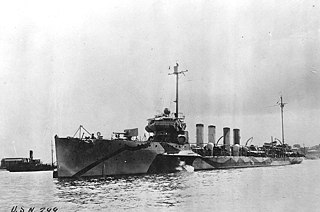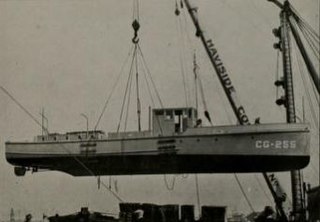
USS Paulding (DD-22) was the lead ship of Paulding-class destroyers in the United States Navy. She served in the United States Coast Guard as CG-17. She was named for Rear Admiral Hiram A. Paulding USN (1797-1878).

USS Conyngham was a Tucker-class destroyer built for the United States Navy prior to the American entry into World War I. The ship was the first U.S. Navy vessel named for Gustavus Conyngham.

USCGC Onondaga (WPG-79), a United States Coast Guard cutter, was built by Defoe Boat Works in Bay City, Michigan, commissioned on 11 September 1934. From her commissioning until 1941, Onondaga was stationed at Astoria, Oregon, where she performed important law enforcement duties and rendered much assistance to ships in distress. Each year she patrolled the annual pelagic seal migration to the Pribilof Islands, and she attempted to prevent out of season halibut fishing.

USS Raeo (SP-588) was a United States Navy patrol vessel in commission from 1917 to 1919. Prior to her U.S. Navy service, she operated as the motor passenger vessel Raeo from 1908 to 1917. After the conclusion of her U.S. Navy career, she served as the fishery patrol vessel USFS Kittiwake in the United States Bureau of Fisheries fleet from 1919 to 1940 and as US FWS Kittiwake in the Fish and Wildlife Service fleet from 1940 to 1942 and from 1944 to at least 1945, and perhaps as late as 1948. During World War II, she again served in the U.S. Navy, this time as the yard patrol boat USS YP-199. She was the civilian fishing vessel Raeo from 1948 to 1957, then operated in various roles as Harbor Queen from 1957 to 1997. She became Entiat Princess in 1998 and as of 2009 was still in service.

YP-26 was a former U.S. Coast Guard wooden patrol boat which saw later duty with the U.S. Navy until destroyed in a 1942 accident.

The USS YP-73 (ex-Corsair) was a converted fishing vessel which served as an auxiliary patrol boat in the U.S. Navy during World War II.

The United States Coast Guard wooden-hulled 75-foot patrol boats were built during Prohibition to help interdict alcohol smugglers. Their nickname was derived from the slang term "six bits" meaning 75 U.S. cents.

USS YP-16 was a wooden-hulled patrol vessel in commission in the fleet of the United States Coast Guard as CG-267 from 1925 to 1934, and in the fleet of the United States Navy as YP-16 from 1934 until 1941. She was sunk by Japanese aircraft during the Japanese attack on Guam.

USS YP-17 was a wooden-hulled patrol vessel in commission in the fleet of the United States Coast Guard as CG-275 from 1925 to 1933, and in the fleet of the United States Navy as YP-17 from 1933 until 1941. She was captured by Japanese forces during the Japanese attack on Guam.

USS YP-18 was a wooden-hulled patrol vessel in commission in the fleet of the United States Coast Guard as CG-263 from 1925 to 1934, and in the fleet of the United States Navy as YP-18 from 1934 until 1938.

USS YP-10 was a wooden-hulled patrol vessel in commission in the fleet of the United States Coast Guard as CG-194 from 1925 to 1934, and in the fleet of the United States Navy as YP-10 from 1934 until 1941.

USS YP-15 was a wooden-hulled patrol vessel in commission in the fleet of the United States Coast Guard as CG-149 from 1925 to 1933, and in the fleet of the United States Navy as YP-15 from 1933 until 1945.

USS YP-45 was a wooden-hulled patrol vessel in commission in the fleet of the United States Coast Guard as CG-133 from 1925 to 1934, and in the fleet of the United States Navy as YP-45 from 1934 until 1945.

USS YP-49 was a wooden-hulled patrol vessel in commission in the fleet of the United States Coast Guard as CG-182 from 1925 to 1934, and in the fleet of the United States Navy as YP-49 from 1934 until 1943.
CG-107 was a wooden-hulled patrol vessel in commission in the fleet of the United States Coast Guard.
CG-113 was a wooden-hulled patrol vessel in commission in the fleet of the United States Coast Guard.
CG-108 was a wooden-hulled patrol vessel in commission in the fleet of the United States Coast Guard.
CG-249 was a wooden-hulled patrol vessel in commission in the fleet of the United States Coast Guard.

USS YP-51 was a wooden-hulled patrol vessel in commission in the fleet of the United States Coast Guard as CG-261 from 1925 to 1934, and in the fleet of the United States Navy as YP-51 from 1934 until 1945.

CG-74339 was a wooden-hulled patrol vessel in commission in the fleet of the United States Coast Guard.










